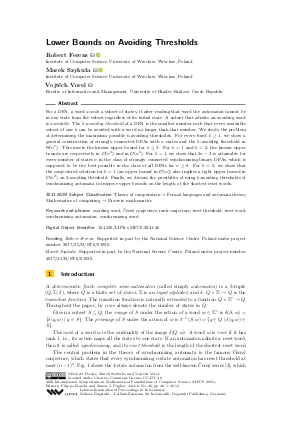Lower Bounds on Avoiding Thresholds
Authors
Robert Ferens  ,
Marek Szykuła
,
Marek Szykuła  ,
Vojtěch Vorel
,
Vojtěch Vorel
-
Part of:
Volume:
46th International Symposium on Mathematical Foundations of Computer Science (MFCS 2021)
Part of: Series: Leibniz International Proceedings in Informatics (LIPIcs)
Part of: Conference: Mathematical Foundations of Computer Science (MFCS) - License:
 Creative Commons Attribution 4.0 International license
Creative Commons Attribution 4.0 International license
- Publication Date: 2021-08-18
File

PDF
LIPIcs.MFCS.2021.46.pdf
- Filesize: 0.67 MB
- 14 pages
Document Identifiers
Subject Classification
ACM Subject Classification
- Theory of computation → Formal languages and automata theory
- Mathematics of computing → Discrete mathematics
Keywords
- avoiding word
- Černý conjecture
- rank conjecture
- reset threshold
- reset word
- synchronizing automaton
- synchronizing word
Metrics
- Access Statistics
-
Total Accesses (updated on a weekly basis)
0Document
0Metadata
Abstract
For a DFA, a word avoids a subset of states, if after reading that word the automaton cannot be in any state from the subset regardless of its initial state. A subset that admits an avoiding word is avoidable. The k-avoiding threshold of a DFA is the smallest number such that every avoidable subset of size k can be avoided with a word no longer than that number. We study the problem of determining the maximum possible k-avoiding thresholds. For every fixed k ≥ 1, we show a general construction of strongly connected DFAs with n states and the k-avoiding threshold in Θ(n^k). This meets the known upper bound for k ≥ 3. For k = 1 and k = 2, the known upper bounds are respectively in 𝒪(n²) and in 𝒪(n³). For k = 1, we show that 2n-3 is attainable for every number of states n in the class of strongly connected synchronizing binary DFAs, which is supposed to be the best possible in the class of all DFAs for n ≥ 8. For k = 2, we show that the conjectured solution for k = 1 (an upper bound in 𝒪(n)) also implies a tight upper bound in 𝒪(n²) on 2-avoiding threshold. Finally, we discuss the possibility of using k-avoiding thresholds of synchronizing automata to improve upper bounds on the length of the shortest reset words.
Cite As Get BibTex
Robert Ferens, Marek Szykuła, and Vojtěch Vorel. Lower Bounds on Avoiding Thresholds. In 46th International Symposium on Mathematical Foundations of Computer Science (MFCS 2021). Leibniz International Proceedings in Informatics (LIPIcs), Volume 202, pp. 46:1-46:14, Schloss Dagstuhl – Leibniz-Zentrum für Informatik (2021)
https://doi.org/10.4230/LIPIcs.MFCS.2021.46
BibTex
@InProceedings{ferens_et_al:LIPIcs.MFCS.2021.46,
author = {Ferens, Robert and Szyku{\l}a, Marek and Vorel, Vojt\v{e}ch},
title = {{Lower Bounds on Avoiding Thresholds}},
booktitle = {46th International Symposium on Mathematical Foundations of Computer Science (MFCS 2021)},
pages = {46:1--46:14},
series = {Leibniz International Proceedings in Informatics (LIPIcs)},
ISBN = {978-3-95977-201-3},
ISSN = {1868-8969},
year = {2021},
volume = {202},
editor = {Bonchi, Filippo and Puglisi, Simon J.},
publisher = {Schloss Dagstuhl -- Leibniz-Zentrum f{\"u}r Informatik},
address = {Dagstuhl, Germany},
URL = {https://drops.dagstuhl.de/entities/document/10.4230/LIPIcs.MFCS.2021.46},
URN = {urn:nbn:de:0030-drops-144869},
doi = {10.4230/LIPIcs.MFCS.2021.46},
annote = {Keywords: avoiding word, \v{C}ern\'{y} conjecture, rank conjecture, reset threshold, reset word, synchronizing automaton, synchronizing word}
}
Author Details
Funding
- Ferens, Robert: Supported in part by the National Science Centre, Poland under project number 2017/25/B/ST6/01920.
- Szykuła, Marek: Supported in part by the National Science Centre, Poland under project number 2017/25/B/ST6/01920.
References
-
M. V. Berlinkov, R. Ferens, and M. Szykuła. Preimage problems for deterministic finite automata. Journal of Computer and System Sciences, 115:214-234, 2021.

-
J. Černý. Poznámka k homogénnym eksperimentom s konečnými automatami. Matematicko-fyzikálny Časopis Slovenskej Akadémie Vied, 14(3):208-216, 1964. In Slovak.

-
H. Don. The Černý Conjecture and 1-Contracting Automata. Electronic Journal of Combinatorics, 23(3):P3.12, 2016.

-
F. Gonze and R. M. Jungers. Hardly Reachable Subsets and Completely Reachable Automata with 1-Deficient Words. Journal of Automata, Languages and Combinatorics, 24(2-4):321-342, 2019.

-
F. Gonze, R. M Jungers, and A. N. Trahtman. A Note on a Recent Attempt to Improve the Pin-Frankl Bound. Discrete Mathematics and Theoretical Computer Science, 17(1):307-308, 2015.

-
J. Kari. Synchronizing finite automata on Eulerian digraphs. Theoretical Computer Science, 295(1-3):223-232, 2003.

-
A. Kisielewicz, J. Kowalski, and M. Szykuła. Experiments with Synchronizing Automata. In Implementation and Application of Automata, volume 9705 of LNCS, pages 176-188. Springer, 2016.

-
J.-E. Pin. On two combinatorial problems arising from automata theory. In Proceedings of the International Colloquium on Graph Theory and Combinatorics, volume 75 of North-Holland Mathematics Studies, pages 535-548, 1983.

-
I. K. Rystsov. Polynomial complete problems in automata theory. Information Processing Letters, 16(3):147-151, 1983.

-
I. K. Rystsov. Quasioptimal Bound for the Length of Reset Words for Regular Automata. Acta Cybernetica, 12(2):145-152, 1995.

-
Y. Shitov. An Improvement to a Recent Upper Bound for Synchronizing Words of Finite Automata. Journal of Automata, Languages and Combinatorics, 24(2-4):367-373, 2019.

-
M. Szykuła. Improving the Upper Bound on the Length of the Shortest Reset Word. In STACS 2018, LIPIcs, pages 56:1-56:13. Schloss Dagstuhl-Leibniz-Zentrum fuer Informatik, 2018.

-
A. N. Trahtman. The Cerný conjecture for aperiodic automata. Discrete Mathematics and Theoretical Computer Science, 9(2):3-10, 2007.

-
A. N. Trahtman. Modifying the upper bound on the length of minimal synchronizing word. In Fundamentals of Computation Theory, volume 6914 of LNCS, pages 173-180. Springer, 2011.

-
M. V. Volkov. Synchronizing automata and the Cerný conjecture. In Language and Automata Theory and Applications, volume 5196 of LNCS, pages 11-27. Springer, 2008.

-
M. V. Volkov. Synchronizing automata preserving a chain of partial orders. Theoretical Computer Science, 410(37):3513-3519, 2009.

-
M. V. Volkov, editor. Special Issue: Essays on the Černý Conjecture, volume 24 (2-4) of Journal of Automata, Languages and Combinatorics, 2019.

-
V. Vorel. Subset synchronization and careful synchronization of binary finite automata. Int. J. Found. Comput. Sci., 27(5):557-578, 2016.

